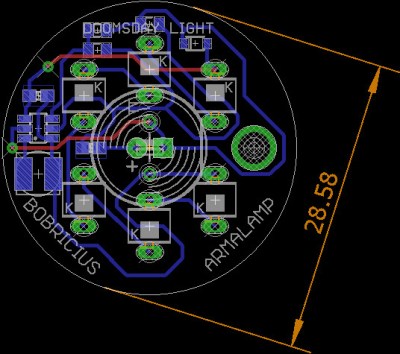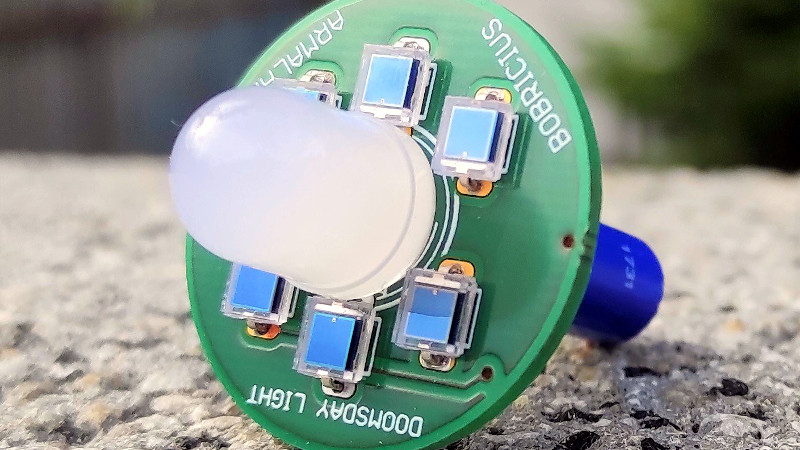Instant access to electric light is a luxury that most of us take for granted, but in times of crisis, the power is often the first thing to go. So whether you’re worried about a natural disaster or the outbreak of war, a reliable source of light is a must-have in your emergency kit. Creator [bobricius] calls his is ArmaLamp the “Armageddon resistant night lamp”, and while we’re not eager to test that particular claim, it certainly looks robust enough to get you through some tough times.
 The basic idea behind the ArmaLamp is to make a light source so simple that, outside of being physically destroyed, it can’t fail. That means deleting the mechanical power switch and designing the circuit so the LED light will kick on automatically in the dark. Rather than using a traditional rechargeable battery, the solar powered ArmaLamp stores its charge in a 10 farad supercapacitor that can be charged and depleted daily without having to worry about long-term degradation.
The basic idea behind the ArmaLamp is to make a light source so simple that, outside of being physically destroyed, it can’t fail. That means deleting the mechanical power switch and designing the circuit so the LED light will kick on automatically in the dark. Rather than using a traditional rechargeable battery, the solar powered ArmaLamp stores its charge in a 10 farad supercapacitor that can be charged and depleted daily without having to worry about long-term degradation.
Charging the ArmaLamp with a simple solar cell is clearly out of the question as it would represent not just a single point of failure, but a particularly fragile one at that. Instead, [bobricius] is using an array of six BPW34 photodiodes that come in a hard plastic package. Combined with an efficient driver circuit that can run the LED even when the supercap is down to 0.3 V, leaving the ArmaLamp outside during the day should provide you with four hours of ultra-reliable light every night.

















i do kind of wish there was an off switch or something though, as this is only useful if you charge it during the day, and then use it immediately at night. If you put it in your pocket or a bag, it will turn on and completely discharge itself.
easy, get a second one and use it to illuinate the first one to turn it off!
Nah, you just have to rotate the diode’s a bit so it catches it’s own light.
Use a mirror…
Or make it so that the switch isn’t for the bulb, but for the light sensor, where if in the event that the switch gets broken or worn out, then the sensor can still switch on the light on its own.
I thought about putting a reed switch in? Virually never fail and you could do something cool with a 3D printed enclosure or cap to keep the magnet attached. I did comment on the project page as I don’t know enough to know where to put the reed switch in the cuircuit to allow charging but prevent the cap discharging/led illuminating. If anyone knows I’d really like to give this a try.
>> leaving the ArmaLamp outside during the day should provide you with four hours of ultra-reliable light every night.
I’m there with the switch idea, too. When the zombies come, If you only get four hours of light, it’s going to be important to be able to pick *which* of those four hours you want.
Otherwise the zombies will just wait for fours after sunset, mulling around in circles muttering “1000 brains, 999 brains, 998 brains” or however zombies count.
You can always tell the vegan zombies..
“1000 grains, 999 grains, 998 grains..”
How about a hall effect sensor? Put a magnet near, and it turns off.
A reed switch would be simpler
reed switch is too fragile
The biggest source of failure I see in the cheep solar lamps is the epoxy on top of the solar cell yellowing from sunlight exposure, followed by moisture damage. Seems like this design does nothing to address either of those.
Also — shouldn’t the solar cells go on the opposite side of the led?
You have that option if you assemble it yourself :) But in this orientation, all the light that is going toward the PCB is recycled instead of wasted warming up the PCB. It is minuscule, but sometimes every photon counts.
Leave no photon behind!
😢🤣
Make sure the zombie apocalypse you’re participating in only happens at extreme latitudes near an equinox so that the nights are 4 hours or shorter. :-P
Summer solstice, not either of the equinoxes, and you’d only need to be about 60 degrees North or South, it is pretty extreme in the Southern hemisphere but there’s plenty of land and people North of 60 degrees North.
Right, I realized the mistake the second I posted. XD
ok but once you’ve survived 6 month and nights last 20+ h and temperature is below -30 ..you regret you didn’t chose an island in the Caribbean where you can live forever picking up fruits/chickens/goats and smoke ganja
Even though I don’t care about this light, I find it quite surprising to see these photo diodes can harvest enough energy.
It’s probably also enough for a microcontroller that sleeps most of the time and does something useful every now and then.
Although they seem to be relatively expensive at 65ct each (100+ quantities)
Using a regular solar panel and putting it in a decent box is probably a better option, but I have not checked prices.
I use those photodiodes in other applications. They are remarkably good for the price. Tiny, but low dark current, high efficiency. In direct sunlight you can count on 1 mW per diode.
Not enough power? The next contenders are the IXOLAR cells, available from the usual suspects: 30 mW out of a 8x23mm package, but it really needs extra weatherproofing for long-term outdoor use. 30x the power for 4-5x the price of the BPW34s.
KXOB25-01X8F-TB
6 cells in series.
5.5V (Open Circuit)
24.5mW
2.2mA short circuit.
And a semi normal SMT package of 22*7mm.
the LED light above has 6 separate diodes which together cost more then this IXOLAR thing. (USD2.3 each in modest quantities)
A bit unfortunate it is still 2.3*1000*1000/7/22 = 14935 USD per square meter…
I was under the impression that small panels were usually quite high quality monocrystalline ones, and likely to last a very long time. As long as it would take for the PCB to turn to “cheese” if left in direct UV rich sunlight for years.
I like this idea for the decorative garden lights. There are some for little gnome houses, etc.
that is actually a very good use case. the typical garden lights usually are toast after a couple months and barely light up. hand-rolling your own would put these into the affordable range. I cant imagine how much they would go for at retail with a $~20/light bom cost.
If going with redundant solar diodes, why not add a second LED for the light source so that if one fails, the other takes over? Or, is it an issue that a failed LED is rare or would load the circuit so much as to render it inefficient?
LED failure has a few common sources:
1). Low quality LED’s.
2). Running them at too high current (or temperature).
3). Physical abuse.
When decent LED’s are handled properly they have a very long live span.
Though the same thing can be said for solar cells, tilt switch, etc
Sometimes I guess you are designing assuming it won’t be handled properly…
Still for me this is not the right design, I’d go tilt switch – probably really old school one with liquid at x temp metal like mercury (even if the outdoor temp is below that you can use body heat to activate/deactivate as those are almost unkillable, a single or pair of much bigger solar panels so you don’t need much time in daylight or the coil and magnet shake approach (maybe both) and I think a few extra caps – it doesn’t need to be that tiny so might as well add in an extra cap or two.
You could use a thermopile and a heatsink and get light out of where the sun don’t shine.
If you can light things on fire, then why block all the light with inefficient techno crap to get light.
I love the idea to use unexpected parts like the photodiodes.
But I don’t agree with the reasoning
– the diodes are all in series – if one fails this thing is broken. Multiple diodes do not increase reliability (but increase cost and leave some surface unused)
– it is not (yet) designed for robustness – vibration will kill the supercap (better lay it flat and fix it to the board), conformal coating? No mounting points for a housing
– it would need a way to decide when to use the 4 hours of light, and not run empty in the backpack. Keeping the design choice “no switch” is possible, but one would need to scale up the storage/harvesting to 24h
Really no switch. The description should then read. Leaves you in the darkness for most of the night. This is just an overengineered garden light.
I want to see what happens when you take 2 of them and point them at each other in a dark room. In theory, if you can get them to trigger at the same time and the reaction times are the same, then you get a strobe light with a frequency based on the reaction time of the lights.
In reality though, whichever one triggers first should keep the other one off and even charge it a little so you may end up with over 8 hours of light. One stays on for 4 hours until the charge is too low then the other one lights up and begins charging the other again. Since there are losses and the wavelength of the led probably isn’t optimal for charging with the diodes it obviously won’t run forever but it should go longer than 8 hours if you start with both fully charged.
BPW34 will perhaps provide new twist on “LED Throwies”?
Throwies are cursed
Double (or triple) LEDs and supercaps, but light the second LED when the first one dies and so on. Optimize the layout and it would be a useful little device.